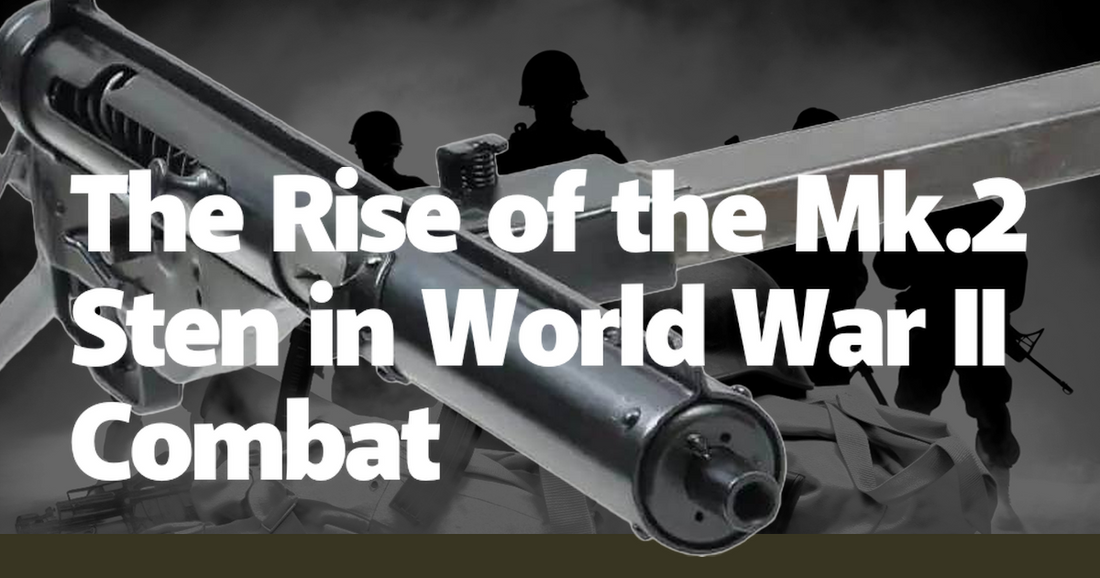The Mk.2 Sten gun emerged as a pivotal weapon in World War II, embodying both the ingenuity and desperation of wartime innovation. Conceived in 1941 by Major Reginald V. Shepherd and Harold Turpin, the Sten gun was a response to the British Army's dire need for a cost-effective, rapid-fire weapon. With the fall of France and the Dunkirk evacuation, Britain faced a critical shortage of arms. The Sten's design was a masterstroke of simplicity and functionality. Comprising just 47 parts, it could be manufactured quickly and inexpensively, a stark contrast to the more complex and costly Thompson submachine guns used by American forces. This ease of production allowed the Sten to be churned out in vast numbers, with over four million units produced by war's end.
The Mk.2 variant, in particular, became the most iconic version of the Sten gun. Its utilitarian design featured a straight blowback operation and a side-mounted magazine, which gave it a distinctive profile. The weapon was light, weighing only 7 pounds, and had a cyclic rate of 500 rounds per minute, making it highly effective in close-quarters combat. Its simplicity was both a strength and a weakness; while it was easy to produce and maintain, it was also prone to jamming and accidental discharge. Nevertheless, its availability and ease of use made it a favorite among British and Commonwealth troops, as well as resistance fighters across occupied Europe.
One of the most compelling examples of the Mk.2 Sten's impact came during the D-Day landings. British paratroopers, armed with Sten guns, were dropped behind enemy lines to disrupt German defenses and secure key positions. The Sten's compact size and rapid rate of fire made it ideal for these kinds of operations. In the chaos of the Normandy countryside, the Sten proved invaluable. Paratroopers could easily carry multiple magazines, and the weapon's simple design meant it could be quickly stripped and cleaned in the field. Stories abound of paratroopers using the Sten to great effect, ambushing German patrols and holding strategic points until reinforcements arrived.
The Sten gun also played a crucial role in the hands of resistance fighters across Europe. In occupied France, the Maquis used the Mk.2 Sten to great effect in their guerrilla warfare against the German occupiers. The weapon's ease of disassembly made it easy to smuggle and conceal, and its rapid-fire capability was perfect for hit-and-run tactics. One notable incident involved a group of Maquis fighters ambushing a German convoy in the Vercors region. Armed with Sten guns, the resistance fighters managed to disable several vehicles and inflict significant casualties before melting back into the forest. Such actions not only disrupted German supply lines but also boosted the morale of the local population and the broader Allied war effort.
In the urban warfare that characterized much of the fighting in Italy and Eastern Europe, the Mk.2 Sten again proved its worth. In the brutal house-to-house fighting in cities like Stalingrad and Warsaw, soldiers needed a weapon that was both effective at close range and easy to maneuver in confined spaces. The Sten's compact design and high rate of fire made it ideal for this kind of combat. In Warsaw, during the 1944 uprising, Polish resistance fighters armed with Sten guns held out against vastly superior German forces for 63 days. The Sten's role in such urban battles underscored its versatility and effectiveness in a variety of combat situations.
Despite its many advantages, the Mk.2 Sten was not without its critics. Its rudimentary design and construction led to frequent malfunctions. Soldiers often joked that "Sten" stood for "Stoppage Every Nine," reflecting its tendency to jam. The weapon's magazine was particularly problematic; it was prone to misfeeds and required careful handling to avoid damaging the delicate feed lips. However, soldiers quickly learned to work around these issues, developing a range of field-expedient solutions to keep their Stens operational. The weapon's shortcomings were a small price to pay for its availability and firepower.
The Mk.2 Sten also had a significant psychological impact on both its users and their enemies. For British and Commonwealth troops, the Sten was a symbol of resilience and resourcefulness. It was a weapon born out of necessity, a testament to British ingenuity in the face of adversity. For the Germans, the widespread use of the Sten by resistance fighters and Allied troops was a constant reminder of the growing strength and reach of the Allied war effort. The sight of a Sten gun was often enough to instill fear and uncertainty in German soldiers, who knew that they could face an ambush or a sudden attack at any moment.
By the end of World War II, the Mk.2 Sten had left an indelible mark on the conflict. Its simple yet effective design made it a cornerstone of the British and Allied arsenals, and its widespread use by resistance fighters helped to turn the tide against the Axis powers. While it was eventually replaced by more advanced submachine guns in the post-war years, the legacy of the Mk.2 Sten endures. It remains a symbol of wartime innovation and resourcefulness, a reminder of how necessity can drive remarkable feats of engineering and design. In the annals of military history, the Mk.2 Sten stands as a testament to the power of simplicity and the enduring spirit of those who wielded it.

